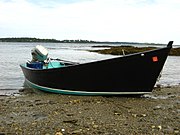Difference between revisions of "AY Honors/Rowing/Answer Key"
(No difference)
|
Revision as of 19:45, 19 September 2006
The term skiff is applied to various river craft, but a skiff is typically a small flat-bottomed open boat with a pointed bow and square stern. Although originally used mainly by fishermen, they are today primarily leisure craft. They usually hold either one person or, more commonly, three (two scullers and a coxswain).
Many modern skiffs do carry a small outboard motor and have a center-console hull design, with a blunt bow, a flat bottom and a square stern. They are relatively inexpensive compared to skiboats or bass boats, and are common "working" boats, filling such jobs as ferrying passengers from the shore to a larger vessel, or employed by crab trappers.
The word has a complicated etymology: it comes from the Middle English skif, which derives from the Old French esquif, which in turn derives from the Old Italian schifo, which is itself of Germanic origin. The word is related to ship.
Skiffs were once very common on the River Thames in England and featured in the famous book about a journey up the Thames in a skiff, Three Men in a Boat.
The term "skif" or "skif dank" is also a term often used in stoner cliques to relate the opinion that something is good, or of high quality.
Skiff are also high performance sailing dinghies. Examples include: 29er, 49er, 18 footer, musto skiff, and International 14.
The Central American version of a skiff is generally called a 'Panga'. The form probably originated from skiffs brought to the region by North American sport-fishers. They form the backbone of the small-scale fishing effort in the region.
Usually between 19 and 28 feet in length, with capacities ranging from 1 to 5 tons. Usually powered by outboard motors of between 45hp and 200hp, they are planing hulls capable of speeds in excess of 35 knots.
The hulls are made of Fiberglass or FRP, heavily reinforced by numerous bulkheads and usually have bow and stern enclosed flotation compartments.
In the hands of an experienced operator they are extremely seaworthy. Most pangas have a working life of between 5 to 10 years if properly maintained.
Most Pangas are made in factories located near major commercial fishing areas. La Reforma, Sinaloa, is the center of Pacific Mexico's manufacturing effort and is home to two of Mexico's most respected panga manufacturers: El Morro and Reformania Vega. A typical panga costs about $6,000.

